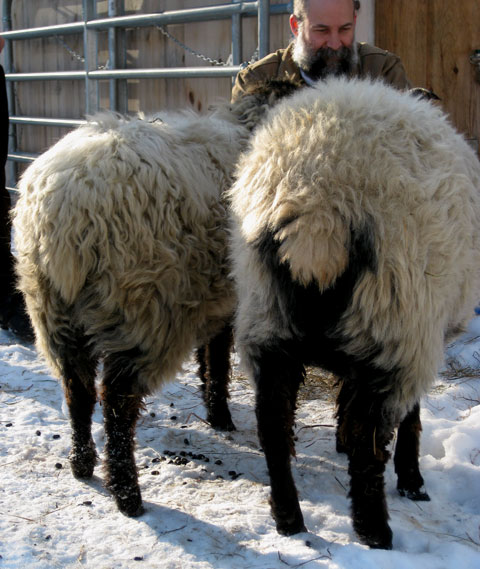
(shepherd shown for scale)
Lambing has been on my mind a lot lately as we prepare for the next phase of our shepherding adventure. Keeping adolescent and adult sheep has, thus far, been easy and fun. Even locating, selecting, and bringing in a breeding ram has been a relatively straightforward experience. We anticipate that raising our own lambs from birth will also be a lot of fun, and of course challenging and exhausting. So we’ve been doing our best to get ready. Although the ewes aren’t due until the end of March, there are details to attend to now.
Diet
We’ve been feeding a high-quality hay during the fall and early winter, and will continue this through the remainder of the ewe’s pregnancies. It’s important to provide enough calories and nutrition without letting the ewes get too fat, as tubby sheep tend to be more susceptible to stuck lambs.
Shearing
I’ve just called our shearer to set up an appointment. Spring is the busiest time for shearing, so it’s important to make arrangements early. Shearing two or three weeks before the ewes are due is important for several reasons. First, it allows us to be able to get a clear view of the sheep’s body, to determine whether they are, in fact, pregnant. Sheep are interesting in that they keep their fetus(es) small until just before birth. Combine this tendency with a winter coat, and it can be difficult to tell who is pregnant, and who is just fuzzy.
Second, shearing before birth keeps the fleece cleaner, and at the same time, provides a clear view of the action during labor and birth. Ewes are also more likely to choose a sheltered location to give birth if they are without their thick sweater. Lastly, shearing provides the added benefit of ease for…
Vaccinations
It’s easiest to administer subcutaneous injections when the sheep are freshly shorn and already restrained during shearing. In the Spring, we administer a CD/T (clostridium types C & D and tetanus) vaccine to all adult sheep. This acts as a booster shot and also ensures some protection for newborn lambs who will get the antibodies from their mother’s milk, before receiving the standard course of inoculations.
There are more details to address before the lambs arrive, so stay tuned for information on supplies and the construction of lambing pens.
